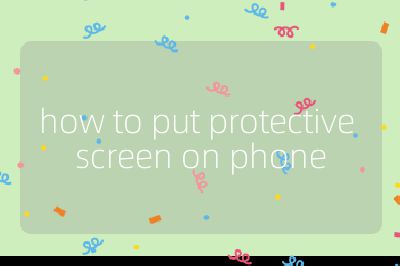How to Put a Protective Screen on Your Phone
1. Gather Your Materials

- Obtain a screen protector that is specifically designed for your phone model. There are different types of screen protectors available, including:
- PET (Polyethylene Terephthalate): A semi-hard, slick, clear material that is common and generally effective.
- Tempered Glass: A very hard and scratch-resistant option that can break but protects the screen from scratches.
- Polycarbonate: A tough plastic that provides impact protection but may not be as scratch-resistant.
- Soft Vinyl Plastic: Generally less recommended due to its lower quality.
2. Prepare Your Workspace
- Choose a low-dust environment to minimize the risk of dust particles getting trapped under the protector. A good method is to run a hot shower to create steam, which helps settle dust in the air.
3. Clean Your Hands and Device
- Wash your hands thoroughly and dry them with a clean towel to avoid transferring oils or dirt onto the screen protector.
- Clean your phone’s screen using an alcohol wipe or a damp cloth with mild soap. Ensure you remove any lint or residue using a microfiber cloth.
4. Check Placement of the Screen Protector
- Before removing any backing, position the screen protector over your device’s screen to determine how it aligns with edges and features like cameras or microphones. This step ensures proper fit and alignment.
5. Remove Dust Particles
- Use a sticky note or dust sticker to pick up any remaining dust on the screen. Look at the reflection of light at an angle to check for dust particles.
6. Apply the Screen Protector
- Carefully peel back one end of the protective backing from the screen protector while keeping it aligned with one edge of your device’s screen.
- Slowly lay down the protector onto the screen, starting from one edge and moving towards the other side while smoothing it down gently.
7. Eliminate Air Bubbles
- If bubbles appear under the protector, use your fingers to push them toward the edges of the screen gently. It may take 24 to 48 hours for all bubbles to disappear completely as they can diffuse out through the material over time.
By following these steps carefully, you can successfully apply a protective screen on your phone without leaving air bubbles or dust underneath.
Top 3 Authoritative Sources Used in Answering this Question
wikiHow: A well-known online resource providing detailed how-to guides on various topics, including technology and device care.
Stan Kats’ Profile: Stan Kats is a Professional Technologist with extensive experience in IT consulting, offering insights into technology solutions for individuals and businesses.
Consumer Reports: An independent nonprofit organization that provides unbiased product testing and reviews, including evaluations of electronic accessories like screen protectors.
